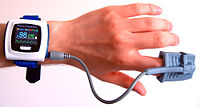
Photo from wikipedia
In this study, we show the results of CCHD screening using pulse oximetry at a tertiary birth hospital and the impact of a modified screening algorithm. BrightcoveDefaultPlayer10.1542/6138651487001PEDS-VA_2017-4065 Video Abstract OBJECTIVES:… Click to show full abstract
In this study, we show the results of CCHD screening using pulse oximetry at a tertiary birth hospital and the impact of a modified screening algorithm. BrightcoveDefaultPlayer10.1542/6138651487001PEDS-VA_2017-4065 Video Abstract OBJECTIVES: Determine the performance of the American Academy of Pediatrics (AAP) critical congenital heart disease (CCHD) newborn screening algorithm and the impact of an alternative algorithm. METHODS: Screening was performed on term infants without a known CCHD diagnosis at or near 24 hours of age at a tertiary birth hospital by using the AAP algorithm from 2013 to 2016. Retrospective review from the birth hospital and the area’s sole pediatric cardiac center identified true- and false-positives and true- and false-negatives. A simulation study modeled the results of a modified screening algorithm with a single repeat pulse oximetry test instead of 2. RESULTS: Screening results were collected on 77 148 newborns . By using the current AAP algorithm, 77 114 (99.96%) infants passed screening, 18 infants failed for an initial saturation of <90%, and 16 failed after not attaining a passing pulse oximetry level after 3 tests. There was 1 true-positive (total anomalous pulmonary venous return), 33 false-positives, and 6 false-negatives, yielding an overall specificity of 99.96%, a sensitivity of 14.3%, and a false-positive rate of 0.043%. Among false-positives, 10 (31.3%) had significant non-CCHD disease. Simulating the modified algorithm, sensitivity remained at 14.3%, and the false-positive rate increased to 0.054%. CONCLUSIONS: Although CCHD screening in a tertiary care birth hospital may not detect many new cases of CCHD, it can detect other important diseases in newborns. Modifying the screening algorithm to 1 repeat pulse oximetry test instead of 2 may detect additional infants with significant disease without a substantial increase in the false-positive rate.
Journal Title: Pediatrics
Year Published: 2018
Link to full text (if available)
Share on Social Media: Sign Up to like & get
recommendations!